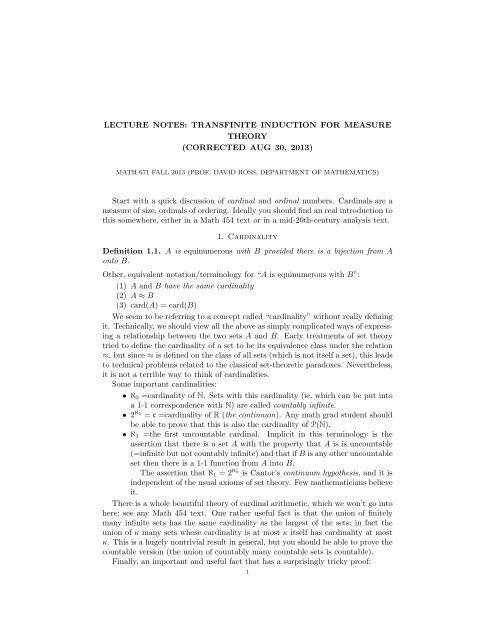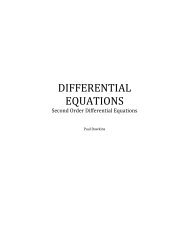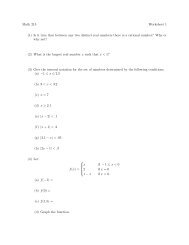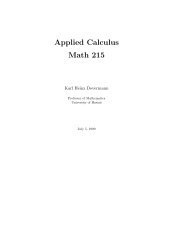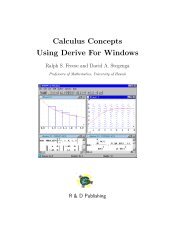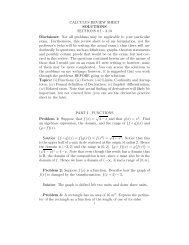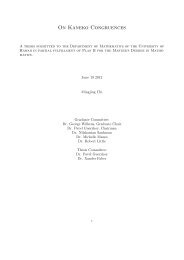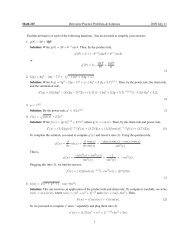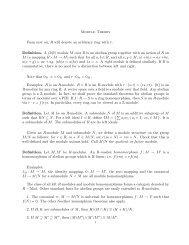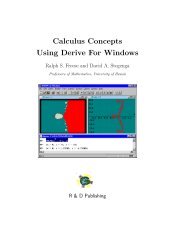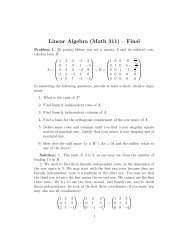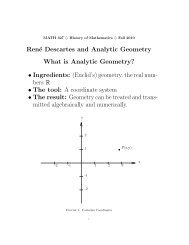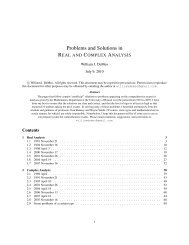TRANSFINITE INDUCTION FOR MEASURE THEORY
TRANSFINITE INDUCTION FOR MEASURE THEORY
TRANSFINITE INDUCTION FOR MEASURE THEORY
Create successful ePaper yourself
Turn your PDF publications into a flip-book with our unique Google optimized e-Paper software.
LECTURE NOTES: <strong>TRANSFINITE</strong> <strong>INDUCTION</strong> <strong>FOR</strong> <strong>MEASURE</strong><br />
<strong>THEORY</strong><br />
(CORRECTED AUG 30, 2013)<br />
MATH 671 FALL 2013 (PROF: DAVID ROSS, DEPARTMENT OF MATHEMATICS)<br />
Start with a quick discussion of cardinal and ordinal numbers. Cardinals are a<br />
measure of size, ordinals of ordering. Ideally you should find an real introduction to<br />
this somewhere, either in a Math 454 text or in a mid-20th-century analysis text.<br />
1. Cardinality<br />
Definition 1.1. A is equinumerous with B provided there is a bijection from A<br />
onto B.<br />
Other, equivalent notation/terminology for “A is equinumerous with B”:<br />
(1) A and B have the same cardinality<br />
(2) A ≈ B<br />
(3) card(A) = card(B)<br />
We seem to be referring to a concept called “cardinality” without really defining<br />
it. Technically, we should view all the above as simply complicated ways of expressing<br />
a relationship between the two sets A and B. Early treatments of set theory<br />
tried to define the cardinality of a set to be its equivalence class under the relation<br />
≈, but since ≈ is defined on the class of all sets (which is not itself a set), this leads<br />
to technical problems related to the classical set-theoretic paradoxes. Nevertheless,<br />
it is not a terrible way to think of cardinalities.<br />
Some important cardinalities:<br />
• ℵ 0 =cardinality of N. Sets with this cardinality (ie, which can be put into<br />
a 1-1 correspondence with N) are called countably infinite.<br />
• 2 ℵ0 = c =cardinality of R (the continuum). Any math grad student should<br />
be able to prove that this is also the cardinality of P(N).<br />
• ℵ 1 =the first uncountable cardinal. Implicit in this terminology is the<br />
assertion that there is a set A with the property that A is is uncountable<br />
(=infinite but not countably infinite) and that if B is any other uncountable<br />
set then there is a 1-1 function from A into B.<br />
The assertion that ℵ 1 = 2 ℵ0 is Cantor’s continuum hypothesis, and it is<br />
independent of the usual axioms of set theory. Few mathematicians believe<br />
it.<br />
There is a whole beautiful theory of cardinal arithmetic, which we won’t go into<br />
here; see any Math 454 text. One rather useful fact is that the union of finitely<br />
many infinite sets has the same cardinality as the largest of the sets; in fact the<br />
union of κ many sets whose cardinality is at most κ itself has cardinality at most<br />
κ. This is a hugely nontrivial result in general, but you should be able to prove the<br />
countable version (the union of countably many countable sets is countable).<br />
Finally, an important and useful fact that has a surprisingly tricky proof:<br />
1
2 MATH 671 FALL 2013 (PROF: DAVID ROSS, DEPARTMENT OF MATHEMATICS)<br />
Theorem 1.1. (Cantor-Schroeder-Bernstein) If A has the same cardinality as a<br />
subset of B and vice versa, then card(A) = card(B).<br />
2. Ordinals<br />
Just as cardinality is meant to be a measure of a set’s size, ordinality is meant to<br />
be a measure of the order structure of a set. When discussing a queue of people, for<br />
example, we might say that a person is 5th in line. This has cardinality implications<br />
- the set of people from the front to/including him has 5 people in it - but also an<br />
ordinality implication: 5 indicates his place in the line’s order.<br />
Intuitively, an ordinal is a well-ordered set which represents all well ordered sets<br />
with a given ‘order type’ (that is, it represents all well-ordered sets which are orderisomorphic<br />
to it). Ordinals are meant to generalize the natural numbers, and the<br />
order relation on ordinals will just be set membership ∈.<br />
Here is one way to define them:<br />
Definition 2.1. An ordinal number is a well-ordered set (α,
LECTURE NOTES: <strong>TRANSFINITE</strong> <strong>INDUCTION</strong> <strong>FOR</strong> <strong>MEASURE</strong> <strong>THEORY</strong>(CORRECTED AUG 30, 2013)3<br />
To get a sense of why transfinite induction works, suppose φ(x) is some statement<br />
we’re trying to prove holds for all ordinals x (or maybe just all x below some β),<br />
and you prove<br />
(1) φ(0) is true, and<br />
(2) Whenever φ(γ) is true for all γ < α then φ(α) is true.<br />
(Note that the first condition is actually implied by the second, so redundant.) The<br />
claim is that φ(α) must be true for all α. Otherwise there is a least exception α, then<br />
the antecedent of the second condition is true, hence φ(α) is true, a contradiction.<br />
Alternately, we prove<br />
(1) φ(0) is true, and<br />
(2) Whenever φ(α) is true then φ(α + 1) is true, and<br />
(3) Whenever φ(α) is true for all α < λ then φ(λ) is true, for limit ordinals λ.<br />
These two approaches correspond to what we call weak and strong induction in a<br />
course like Math 321.<br />
Assuming there exist uncountable ordinals (there do!), there must be a least one,<br />
which we call ω 1 . An interesting property of ω 1 is that if A ⊆ ω 1 is a countable<br />
set of ordinals, that is, A = {α n } n∈N with each α n < ω 1 , then for some β we have<br />
α n < β < ω 1 for all n. (This is a consequence of the fact that the union of a<br />
countable set of countable sets is countable, another general fact any math grad<br />
student should be able to prove.)<br />
3. Generating a σ−algebra<br />
We are now ready to generate a σ − algebra.<br />
Lemma 3.1. Suppose {∅, Ω} ⊆ C ⊆ P(Ω). Define:<br />
(1)<br />
(2)<br />
A 0 := C;<br />
A α+1 := A α ∪ {A ∁ : A ∈ A α } ∪ { ⋃ n<br />
A n : {A n } n∈N ⊆ A α }<br />
(3)<br />
A λ := ⋃ α
4 MATH 671 FALL 2013 (PROF: DAVID ROSS, DEPARTMENT OF MATHEMATICS)<br />
(and therefore a countable union of such intervals), B R = σ(C) where C is the<br />
countable collection of such open intervals.<br />
Define A ω1 as above. We prove by induction that for all α ≤ ω 1 , card(A α ) ≤ 2 ℵ0 .<br />
card(A 0 ) = ℵ 0 . Assume card(A α ) ≤ 2 ℵ0 . Every element of A α+1 is either an<br />
element of A α , the complement of an element of A α , or a set determined by a<br />
function from N into A α . The cardinality of such functions is also 2 ℵ0 . 1 Thus A α+1<br />
is the union of three sets each of cardinality at most 2 ℵ0 , so it has cardinality at<br />
most 2 ℵ0 . Finally, A ω1 is the union of at most 2 ℵ0 many sets each of cardinality at<br />
most 2 ℵ0 , so it too has cardinality at most 2 ℵ0 . In fact, every singleton set of the<br />
form {r} for r a real number is Borel (why?), so B R = A ω1 has cardinality of the<br />
continuum.<br />
We’ll see another way to prove this later in the semester.<br />
You won’t find this fact stated, let alone proved, in many intro analysis or intro<br />
probability texts, and that is a pity.<br />
By the way, Cantor showed that if X is any set, then card(X) is strictly less than<br />
card(P(X). Since there are only as many Borel sets as there are real numbers, these<br />
cardinality considerations show that there are subsets of R which are not Borel.<br />
1 You can show this by finding a 1-1 function from (the set of functions from N to R) into R,<br />
then applying the Cantor-Schroeder-Bernstein Theorem.


